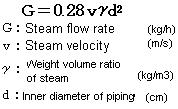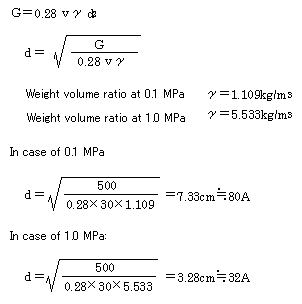For Steam System : Merits of Pressure Reducing Valve
Pressure reducing valve is a regulating valve which maintains the fluid pressure of outlet side to a certain fixed pressure, which is lower than the fluid pressure of inlet side.
The main purpose of pressure reducing valve is not only merely lowering pressure, but is controlling the flow rate by load fluctuation dynamically.
Although a pressure reducing valve has differences in operation systems, there is no great difference theoretically in that pressure reduction is performed by "throttling" with an orifice.
Therefore, using the change of state caused by steam adiabatic expansion, not only the pressure changes after the pressure reducing valve but temperature, latent heat, and specific volume bulk change.
Effects caused by these changes are as follows:
1. Quality Improvement of Steam
Pressure reduction is use of steam adiabatic expansion. Since the amount of latent heat changes in connection with a pressure change, degree of dryness improves.
For example, if the saturated steam of 0.7MPa and 95% of degree of dryness is reduced to pressure of 0.1 MPa,
| Latent heat of 0.7MPa and 95% of the degree of dryness | : 2,055kJ/kg × 0.95 ≒ 1,952kJ/kg (A) |
| Sensible heat of 0.7MPa | : 719kJ/kg (B) |
|
|
|
| Total heat amount = A + B = 1,952kJ/kg + 719kJ/kg = 2,671kJ/kg (C) | |
When reducing pressure, assuming that there is no heat loss by friction of passing the pressure reducing valve or heat release,
Subtracting the amount of sensible heat from all the quantity of heat, the amount of latent heat can be calculated.
Steam of 0.7MPa with 95% of degree of dryness is reduced to 0.1 MPa, the degree of dryness improve from 95% to 98.1%.
Moreover, by supplying steam with the high degree of dryness, the condensate film of the heat transfer surface in the system can be made thin, and it results in raising heat exchange capability.
2. Energy Saving by Increase of Latent Heat by Pressure Reduction
For saturated steam, the higher the pressure is, the smaller the latent heat which the steam contains become, and the larger the sensible heat become.
This means that, the higher pressure, the larger the heat quantity loss for using for indirect heating.
In case of indirect heating, if steam of higher pressure more than needed is used, the heat quantity loss increases very much. Therefore energy saving can be performed by increase in the amount of latent heat by pressure reduction effect.
As to how mush pressure can be reduced, it is decided by the temperature conditions of the heat exchange portion and the size of a steam feed opening of are secured, and it become a precondition that the fall of the heat exchange capability by pressure reduction does not occur.
3. Fall of Carry-over
By the present highly efficient boiler, the higher pressure as possible steam is generated with, the lower the carry-over rate of condensate return can be kept. Then steam with high degree of dryness can be supplied.
This raises steam heat exchange effectiveness. It is important in view of productivity and energy saving.
4. Even Heating Condition
By keeping outlet side pressure constant with pressure reducing valve, the heating conditions of a system can be stabilized, the heat exchange speed be set constant. Then even productivity becomes possible.
5. Reduction of Piping Cost
Steam can be conveyed by high pressure to the pressure reducing valve.
By this, the required piping diameter can be kept at the minimum.
Since making the piping diameter small leads to reduction of keeping-warm material or pipe joints, and also to reduction of heat area, the energy-saving effect by reduction of heat amount becomes large.
Advice
In steam piping, pressure loss, noise and wear of the pipe will increase exponentially if the flow velocity become fast in the pipe. Reduction of the piping diameter keeps equipment costs low but makes flow velocity faster. Then, consider a combination of these elements to decide the most economical piping diameters.
Generally,
| Saturated steam | : 20-30 m/s |
| Overheated steam | 30-60 m/s |
[The other points to consider]
If the pressure becomes lower, specific volume of steam is growing rapidly, and become susceptible to resistance in the piping. The pressure loss is the major factor of this. Therefore flow velocity in the piping should be considered enough.
If equipment additions are expected in the future, select the piping diameter much larger than calculated by maximum steam amount.
Calculation of steam flow rate
Weight volume ratio of steam (gamma) becomes smaller rapidly in case of low pressure.
From the calculation formula in the right, when steam flow rate (G) is constant,
piping diameter (d) becomes large if weight volume ratio (gamma) of steam becomes small.
Then, when transporting the steam, using high pressure and reducing pressure just before
the system that requires low-pressure steam lead to cost reduction in material cost of transport piping.

Example Problem
Determine the pipe diameter when transporting 500kg / h steam with the pressures 1.0MPa and 0.1MPa.

As the above, 32A pipe should be used when transporting with the pressure 1.0 MPa, and 80A when 0.1MPa.